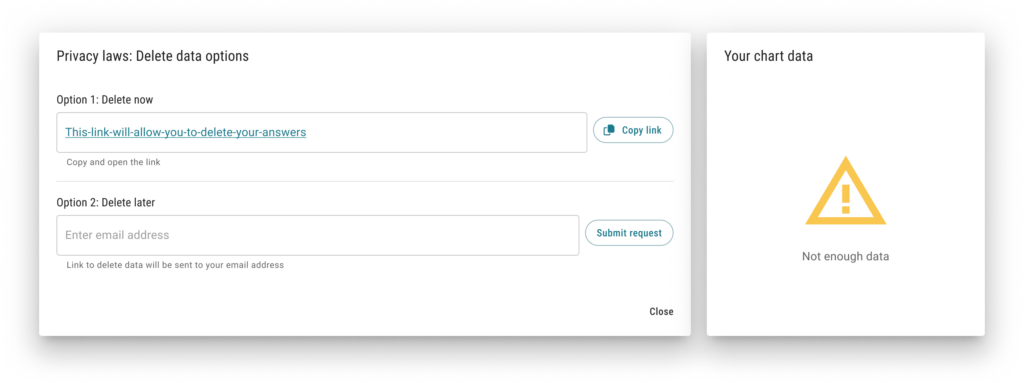
Picture this: You receive an email from your HR or DEI( Diversity, Equity and Inclusion) team asking you to complete some anonymous DEI Surveys priodically. The email assures you anonymity and confidentiality of your data, so you think, “Great! I can answer truthfully without anyone knowing what I said.”
But a few days later, another email pops into your inbox—“We’ve noticed you haven’t completed the survey yet.”
(Cue the awkward confusion.)
If the survey is anonymous, how do they know you haven’t done it yet?
You might be wondering, “Wait a minute… Just how anonymous is anonymous?”
Confidentiality and Anonymity in DEI Surveys: Building Trust in the Workplace
As Diversity, Equity, and Inclusion (DEI) initiatives gain momentum, this is a common scenario. To build trust, participation in surveys and other DEI-related assessments must be truly anonymous—or at least clearly confidential—so that employees feel comfortable providing honest feedback.
There is, however, often confusion between confidentiality and anonymity. This fundamental conceptual dissonance can erode the very trust these efforts are designed to build.
In this post, we’ll break down these concepts and see why they matter in the DEI space, when each of them apply, and answer the question: how private is private?

Private, Confidential, and Anonymous: What’s the Difference?
It’s easy to mix up terms like privacy, confidentiality, and anonymity, but they each have distinct meanings. To be clear:
- Privacy refers to a person’s right to control their personal information and how it’s
shared. In a DEI context, private means employees have control over who knows sensitive details about their identity, background, and beliefs.
- Confidential involves someone knowing your identity but agreeing to keep it secret. For example, in a confidential DEI survey, HR or the DEI team might track who responds but ensures that individual responses are not tied to specific names when reporting the data.
- Anonymous means no one, not even the person collecting the data, knows who you are. anonymous DEI surveys do not track who responds or link any individual’s answers to their identity. Even if the organisation wanted to follow up with the individual who had revealed something of interest in the survey, they couldn’t, because they wouldn’t know who gave which responses.
So, back to our email reminder scenario: If an organisation sends you a follow-up for not completing the survey, it’s not anonymous – it’s confidential at best. This distinction is crucial for building trust, particularly in the realm of DEI, where people might hesitate to submit information for fear of judgment or repercussion.
Why These Concepts Matter in DEI
When organisations ask employees to share deeply personal information — such as, their experiences of inclusion or exclusion, gender identity, racial background, or experiences with bias — their people need to feel safe. Understanding the differences between confidentiality and anonymity is a first step towards ensuring that safety.
Anonymity can help remove the fear that someone might link their feedback to their identity. For example, an employee who has faced microaggressions might worry that disclosing this in a confidential survey could lead to repercussions from colleagues or supervisors. If the survey is anonymous, it follows they are far more likely to share their experience.
1. The Impact of Anonymity on Survey Responses: A Case Study
In the realm of social research, understanding how people respond to sensitive questions is essential for obtaining accurate data. A notable study from the 1970s and 1980s explored this phenomenon by examining students’ honesty in disclosing drug use under different conditions. Participants were surveyed in three scenarios: identifying themselves, responding anonymously, and receiving monetary incentives for their answers.
The results revealed a striking difference in honesty based on the survey method. When participants were required to provide their names, they reported significantly lower instances of drug use. However, when anonymity was guaranteed, self-reports soared, reflecting a more honest perspective. Additionally, offering financial incentives led to even higher disclosure rates, as respondents felt more at ease sharing sensitive information.
This research underscores the importance of anonymity and incentivisation in survey design, highlighting how these factors can enhance the reliability of data collected on sensitive topics.
2. Compliance with Regulations
There’s also a legal component to consider. Regulations like the General Data Protection Regulation (GDPR) in Europe emphasize the protection of personal data. Under GDPR, organizations are required to be transparent about how they collect, store, and use personal information. Anonymity can help ensure compliance because anonymous data is not considered personal data under GDPR—meaning it can’t be used to identify an individual.
On the other hand, if a survey is confidential, the organization must ensure it is handling the data responsibly, only using it for its intended purpose, and securing it from unauthorized access. Mismanaging personal data can lead to legal consequences, damaging the organization’s reputation and finances.
3. Building a Culture of Inclusion
Inclusion isn’t just about diversity numbers or checking boxes — it’s about creating a workplace where everyone feels heard, respected, and safe. Anonymity in DEI initiatives is a vital part of that. When employees trust that their feedback or personal experiences will not be used against them, they are more likely to engage and help create a more inclusive environment.
For example, in an anonymous DEI survey, employees might feel free to mention whether they’ve experienced discrimination, unequal opportunities, or biased practices, providing the organisation with critical insights. Confidentiality alone might not offer the same level of comfort, as people might still worry that their identity could be inferred from their responses or metadata.

Protecting Anonymity: A Must in DEI
Anonymity is a necessity in DEI work. It reassures employees that they can contribute openly without fear of backlash or bias, leading to more honest and therefore useful data. From a psychological perspective, knowing that your identity is protected removes a major barrier to participation.
Take another example: imagine a company that wants to assess how comfortable employees are with disclosing their LGBTQI+ identity in the workplace. If the survey is confidential but not anonymous, those who are not yet “out”, or who have had negative experiences, may hesitate to participate or answer truthfully. However, if the survey is anonymous, they’re more likely to provide candid responses that could help the company create a safer, more inclusive environment.
In practice, organisations should be transparent about how they handle survey responses, clearly stating whether a survey is confidential or anonymous. They should also explain the purpose of data collection and how it will be used. Employees deserve to know whether their privacy is truly protected.

Final word
Understanding the difference between confidentiality and anonymity is critical, especially in the DEI landscape. For organisations, safeguarding this trust isn’t just about ethics — it’s about effectiveness and organisations have the responsibility to protect any DEI experience against re-identification. Employees who feel safe, whether through confidential or anonymous channels, will participate more freely and provide the honest feedback necessary to drive meaningful change.
So, the next time you’re told a survey is “anonymous,” don’t be afraid to ask questions. In DEI work, clarity builds trust, and trust is the foundation of progress.
For a demo of Diversity atlas in action and to see how we protect confidentiality, privacy and anonymity of respondants, please contact our team
Share this Post